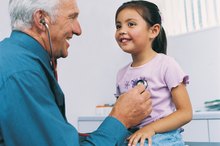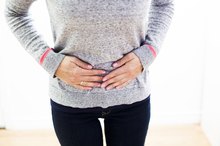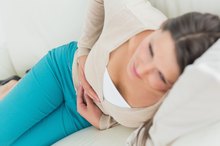Left Side Abdominal Pain in Children
Abdominal pain is a common symptom in children, and can have a myriad of causes, ranging from problems that get better on their own to medical or surgical emergencies 13. Clues to the underlying cause of a child’s abdominal pain include the age of the child, the type of pain -- sharp, dull or crampy, and the duration of the pain. Additional clues include whether the pain has accompanying symptoms such as vomiting or fever, and the location of the pain. Left-sided abdominal pain is most often caused by problems in organs located on the left side, such as the spleen, the left ovary or testicle, and the left side of the large intestine.
If you are experiencing serious medical symptoms, seek emergency treatment immediately.
Acute Left-Sided Pain That Can Occur Throughout Childhood
Several causes of left-sided abdominal pain cause sudden and often severe pain. For example, the spleen – an organ that makes and filters blood cells, and helps fight infection -- is located in the upper left abdomen. Blunt trauma to this part of the abdomen, or even the mid back, can cause injury to the spleen resulting in pain (Ref 1, Etiology section). Moreover, trauma to the spleen can result in a tear of the surrounding capsule, causing severe blood loss from the spleen (Ref 4, p. 1526), a medical emergency. The spleen can also become infected or enlarged, by causes such as Epstein Barr virus infection or congestion from abnormal cells in sickle cell disease, causing left upper abdominal pain. Appendicitis is usually a cause of right-sided abdominal pain, but can actually cause left-sided pain in the rare case of a child born with the appendix located on the left-side of the abdomen (Ref 6, background section).
- Several causes of left-sided abdominal pain cause sudden and often severe pain.
- Blunt trauma to this part of the abdomen, or even the mid back, can cause injury to the spleen resulting in pain (Ref 1, Etiology section).
Acute Left-Sided Abdominal Pain in Older children
My Child Is Complaining of Pain in His Legs
Learn More
Twisting of the left ovary, which is called ovarian torsion, will usually cause:
- intermittent sharp abdominal pain that also may radiate down the left leg (Ref 4
- p 1668)
- usually in girls age 12 years
- over (Ref 1
- Table 2)
Pain occurs because the nerves around the ovary are inflamed. Ovarian torsion is an emergency because of the possibility of loss of the ovary due to impaired blood supply. The same problem of twisting can occur in the left testicle—which most commonly occurs in boys age 12 and over.
- Twisting of the left ovary, which is called ovarian torsion, will usually cause: * intermittent sharp abdominal pain that also may radiate down the left leg (Ref 4
* p 1668)
* usually in girls age 12 years
* over (Ref 1
* Table 2) Pain occurs because the nerves around the ovary are inflamed. - The same problem of twisting can occur in the left testicle—which most commonly occurs in boys age 12 and over.
Chronic Left-Sided Abdominal Pain
Constipation, a common cause of left-sided abdominal pain, is characterized by stools that are infrequent or difficult to pass. The pain is often cramping, and relieved by a bowel movement. Other than abdominal pain, symptoms of constipation that a child may experience include:
- pain during stooling
- blood on the stool or tissue paper after wiping
- fecal soiling
- wetting himself (Ref 2
- p
2). Risk for constipation is increased when a child’s diet is lacking adequate fiber sources, such as vegetables, fruit and whole grains (Ref 3). A left groin hernia can cause abdominal pain. A hernia occurs when abdominal organs, usually the intestine, enter the groin through an opening in the abdominal wall. Parents may notice a bulge in the child’s groin. Half of these cases occur in children under 1 year old. A groin hernia can cause acute pain and become an emergency if it gets trapped in the abdominal wall -- called an incarcerated hernia -- because it chokes off blood flow to the trapped organ (Ref 4, p 1185 -1187).
- Constipation, a common cause of left-sided abdominal pain, is characterized by stools that are infrequent or difficult to pass.
- Risk for constipation is increased when a child’s diet is lacking adequate fiber sources, such as vegetables, fruit and whole grains (Ref 3).
Red Flags
Causes of Left Side Abdominal Pain in Females
Learn More
If a child has abdominal pain that is moderate to severe, that is worsening, or that is constant, her doctor should be notified immediately (Ref 5,’When to Call’). Other red flags include blood in the vomit or stool, recent injury to the abdomen, high fever or age under 2 years old (Ref 5, ‘When to call’).
Related Articles
References
- American Family Physician: Acute Abdominal Pain in Children
- Italian Journal of Pediatrics: Constipation in Children
- HealthyChildren.org: Abdominal Pain in Children
- Nelson Textbook of Pediatrics, 16th Edition; Robert M. Kliegman M.D., et al.
- BMJ Case Reports: Left-Sided Appendicitis in Children with Congenital Malrotation: A Diagnostic Pitfall in the Emergency Department
- Patterson JW, Dominique E. Acute Abdomen. [Updated 2019 Nov 1]. In: StatPearls [Internet]. Treasure Island (FL): StatPearls Publishing; 2020 Jan-. Available from: https://www.ncbi.nlm.nih.gov/books/NBK459328/
- Schachter H. Indigestion and Heartburn. In: Walker HK, Hall WD, Hurst JW, editors. Clinical Methods: The History, Physical, and Laboratory Examinations. 3rd edition. Boston: Butterworths; 1990. Chapter 83. Available from: https://www.ncbi.nlm.nih.gov/books/NBK409/
- Sherman R. Abdominal Pain. In: Walker HK, Hall WD, Hurst JW, editors. Clinical Methods: The History, Physical, and Laboratory Examinations. 3rd edition. Boston: Butterworths; 1990. Chapter 86. Available from: https://www.ncbi.nlm.nih.gov/books/NBK412/
- Patterson JW, Dominique E. Acute Abdomen. [Updated 2019 Nov 1]. In: StatPearls [Internet]. Treasure Island (FL): StatPearls Publishing; 2020 Jan-.
- Schachter H. Indigestion and Heartburn. In: Walker HK, Hall WD, Hurst JW, editors. Clinical Methods: The History, Physical, and Laboratory Examinations. 3rd edition. Boston: Butterworths; 1990. Chapter 83.
- Sherman R. Abdominal Pain. In: Walker HK, Hall WD, Hurst JW, editors. Clinical Methods: The History, Physical, and Laboratory Examinations. 3rd edition. Boston: Butterworths; 1990. Chapter 86.
- Shi XZ, Lin YM, Hegde S. Novel Insights Into the Mechanisms of Abdominal Pain in Obstructive Bowel Disorders. Front Integr Neurosci. 2018;12:23. Published 2018 Jun 8. doi:10.3389/fnint.2018.00023
- Velissaris D, Karanikolas M, Pantzaris N, et al. Acute Abdominal Pain Assessment in the Emergency Department: The Experience of a Greek University Hospital. J Clin Med Res. 2017;9(12):987–993. doi:10.14740/jocmr3206w
- Macaluso CR, Mcnamara RM. Evaluation and management of acute abdominal pain in the emergency department. Int J Gen Med. 2012;5:789-97. doi:10.2147/IJGM.S25936
- Heading RC. Prevalence of upper gastrointestinal symptoms in the general population: a systematic review. Scand J Gastroenterol Suppl. 1999;231:3–8.
- Lyon C, Clark DC. Diagnosis of acute abdominal pain in older patients. Am Fam Physician. 2006;74(9):1537–1544.
- Morino M, Pellegrino L, Castagna E, Farinella E, Mao P. Acute nonspecific abdominal pain: A randomized, controlled trial comparing early laparoscopy versus clinical observation. Ann Surg. 2006;244(6):881–888. doi:10.1097/01.sla.0000246886.80424.ad
Writer Bio
Ruben J. Nazario has been a medical writer and editor since 2007. His work has appeared in national print and online publications. Nazario is a graduate of the University of Louisville School of Medicine, and is board-certified in pediatrics. He also has a Master of Arts in liberal studies from Skidmore College in Saratoga Springs, N.Y.






